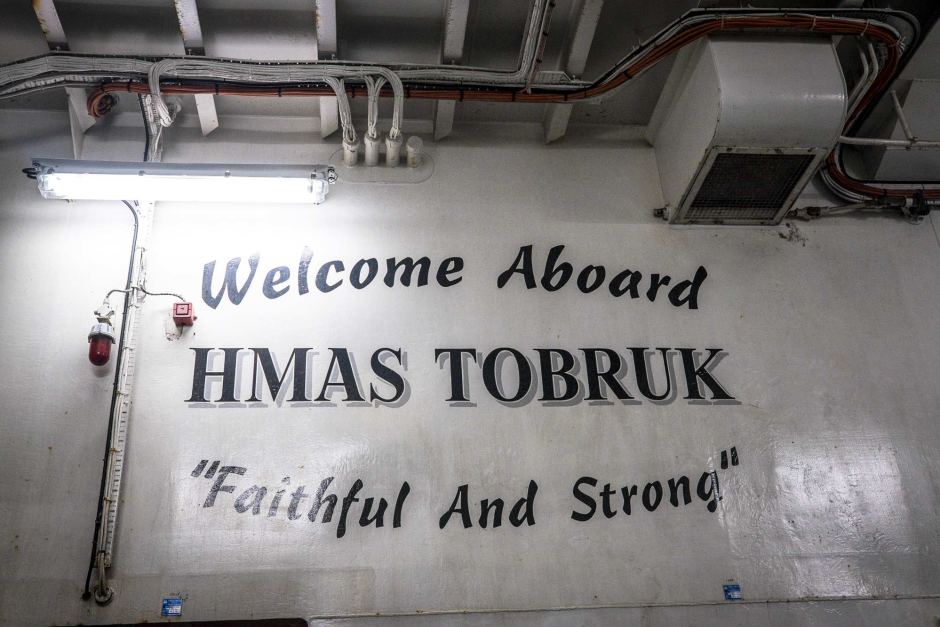|
|
||||||||||||||||||||||||||||||||||||||||
|
||||||||||||||||||||||||||||||||||||||||
|
Privacy Policy | Editorial Policy | Profit Policy | Join the Association | List of Members | Contact us | Index | Links |
||||||||||||||||||||||||||||||||||||||||
|
Back Go to page: 1 2 3 4 5 6 7 8 9 10 11 12 13 14 15 16 17 18 19 20 Forward
|
||||||||||||||||||||||||||||||||||||||||
|
|
||||||||||||||||||||||||||||||||||||||||
|
|
||||||||||||||||||||||||||||||||||||||||
|
HMAS Toowoomba (II), whose home port is HMAS Stirling in the West and whose motto is Fearless, is the seventh of eight Anzac Class long range guided missile Frigates built for the Royal Australian Navy by Tenix Defence Systems in Williamstown, Victoria. Two have also been built for the New Zealand Navy. At the time, Australian shipbuilding was thought to be incapable of warship design, so the RAN decided to take a proven foreign design and modify it. These ships are a rough copy of the German Meko 200 Frigate. Their modular design allowed sections to be constructed throughout Australia and New Zealand with all the pieces brought to Williamstown for final assembly. The first frigate of this type, the HMAS Anzac, which is numbered FFH150, (the FFH standing for Fast Frigate Helicopter) was commissioned in May 1996.
Australia received its ships as below:
|
||||||||||||||||||||||||||||||||||||||||
|
||||||||||||||||||||||||||||||||||||||||
|
Each ship is 118 metres long, 14.8 metres wide and needs 4.35 metres of water so as not to scrape its bottom. Fully laden they weigh 3,600 tonnes. They will run all day at 18 knots and if needed can reach speeds in excess of 25 knots.
|
||||||||||||||||||||||||||||||||||||||||
|
|
||||||||||||||||||||||||||||||||||||||||
|
We would think being in a warship and all alone out in the middle of
the ocean would put the men and women who operate the ship in some
uncomfortable and scary situations so it’s not surprising that the
builders very wisely included some super sophisticated equipment to
Normally the ship carries 22 officers and 141 sailors.
Each ship also carries its own multi-role Sikorsky S-70B-2 Seahawk
helicopter for anti-submarine, anti-surface warfare and search and
rescue (SAR) capabilities. The Seahawk,
The 17-year, fixed-price contract to build these ships, valued at approximately AU$6 billion, was one of the largest and most successful Defence contracts ever awarded in Australia. From March 1996 to June 2006, 10 Anzac Class ships were delivered on time, on budget and to specification.
They are powered by a
combined diesel or gas (CODOG) propulsion plant which enables
them to sustain speeds of greater than 25 knots and allows an
operational range in
The Spirit of Tasmania, which is 30,000 tonnes, can easily cruise at 27 knots – oh well!!!
In 2007, Toowoomba was deployed to the Persian Gulf as part of
Operation Slipper. In June 2009, she sailed from HMAS Stirling for
her second Middle East deployment and in
HMAS Toowoomba is the 58th Australian warship to deploy to the Middle East since the first Gulf War in 1990.
In support of a United Nations Security Council Resolution, she was assigned to escort merchant shipping and conduct patrols in the International Recommended Transit Corridor (IRTC), a shipping lane extending the Gulf of Aden towards the Somali Basin and the Horn of Africa. On the 20th September 2009, she responded to a call for assistance from the merchant vessel BBC Portugal and successfully prevented an act of high-seas piracy. A Japanese P-3 Orion aircraft and a naval helicopter from the German frigate Bremen provided surveillance support while Toowoomba closed in. A boarding party from Toowoomba confiscated several weapons from the attackers before the skiff was directed to leave the IRTC. While in the region, Toowoomba conducted 20 boardings, spending more than 240 hours inspecting dhows transiting the region, which ultimately saw her seize in excess of half-a-billion dollars (Australian) worth of narcotics which would have otherwise funded terrorist operations.
These drugs are put through an on board munching system then dispersed into the prop wake at the back end of the ship where they instantly and harmlessly disperse.
She returned to Stirling in December 2009, having been relieved in the MEAO by her sister ship, HMAS Stuart. The ship and her company were awarded with a "Certificate for Exceptional Services Rendered to Shipping and Mankind" by the International Maritime Organization in November 2009. In early April 2013, Toowoomba operated with the U.S. Navy's Carrier Strike Group Three in the South China Sea then in March 2014, she was pulled from asylum seeker patrols and directed to join the hunt for the missing Malaysia Airlines flight MH370.
On the
4th June, Toowoomba arrived in Brisbane for a week long visit, after
another tour of
Commanding Officer Commander Cath Hayes.
Commander Cath Hayes was born and raised in Diamond Creek in
Victoria, she joined the Royal Australian Navy in 1992 via the
Australian Defence Force Academy where she
In 1996 Sub-Lieutenant Hayes was posted to HMAS Darwin where she achieved the award of a Bridge Watch-keeping Certificate in 1997. She was promoted to Lieutenant in January 1998 and completed Minor War Vessel Navigation Course before joining HMAS Geelong as the Navigating Officer in late 1998. After two years as the Navigator of Geelong she undertook a short period as Assistant Principle Warfare Officer in HMAS Arunta before undertaking Principle Warfare Officers Course in 2001.
In 2002, upon graduation from Principle Warfare Officers Course as an Air Warfare specialist, Lieutenant Hayes joined NUSHIP Stuart in the final stages of build at Williamstown Dockyard as the Operations Officer. This posting was interrupted by a short notice posting to HMAS Melbourne for training and deployment to the Arabian Gulf on Operation SLIPPER. Lieutenant Hayes returned from Operation SLIPPER to take up a short posting as the FFG Capability Requirements Manager at the Surface Combatant Group before joining HMAS Sydney in 2003 for a further deployment to the Arabian Gulf on Operations SLIPPER and FALCONER.
Lieutenant Hayes joined HMAS Kanimbla in January 2004 as the
Operations Officer and was selected for promotion to Lieutenant
Commander in December 2004. Following the
Lieutenant Commander Hayes assumed Command of Armidale Class Patrol Boat Crew ATTACK FIVE in March 2006. In April 2006 she briefly deployed with the ground forces to the Solomon Islands as the Maritime Liaison Officer for Operation ANODE II, before rejoining her Crew. In June 2006, she was promoted to command HMAS Armidale and during her subsequent 18 month in Command conducted patrols in support of Operation RESOLUTE in HMA Ships Armidale, Bathurst, Albany and Ararat.
She was awarded the Peter Mitchell Prize as the most outstanding officer in the RAN for 2007.
In 2008 she joined the Joint Amphibious Capability Implementation Team which is coordinating the introduction into service of the Australian Defence Forces new amphibious capability. After completing Staff College in 2009 she was posted to the position of Staff Officer to the Vice Chief of the Defence Force and was subsequently promoted to Commander in January 2011 and was posted as the Deputy Director Surface and Air Warfare in Navy Strategic Command. In this position she was responsible for developing capability needs for Navy’s future Surface and Air Warfare and Afloat Support capability replacement programs and was the lead negotiator and planner for the deployment of Spanish Armada Ship SPS Cantabria to Australia in 2013.
Toowoomba left Brisbane on the morning of the 10th June and will probably reach HMAS Stirling in about 10 days where she will be tied up for a while undergoing repairs and an equipment upgrade. A skeleton crew will remain with the ship but most will be posted off to different ships or other shore stations. Commander Hayes assumed her current post as the Commanding Officer of HMAS Toowoomba on the 19th July 2013 and upon reaching Perth, she too will be leaving Toowoomba for a different command.
As Toowoomba had a brief stay in Brisbane, we thought it would be an
ideal opportunity
Early Wednesday morning 10 June, at the un-Godly hour of 7.00am, John Griffiths and I were met at the gate to Hamilton Wharf’s Pier 4 by Lieutenant Commander Ed Ellison (that's Sqn Ldr in the real money) who is the XO (2IC) on HMAS Toowoomba.
The blonde said “I always leave an empty milk carton in the refrigerator just in case some one wants black coffee".
After a brief check-in at the “guard room” we boarded the ship via
the gang way at the
You hear lots of stories about military food, the RAAF was always thought to have the best, but we don’t think that is the case anymore.
Today, possibly because of economies of scale, both the RAAF and the Army are fed by contractors and although they do provide healthy and nutritious meals for the troops, at the back of their minds these companies have to be thinking about profits and the best way to maximise profits is to minimise costs. On this ship, the catering people, cooks and the stewards are all Navy - and it shows. We lined up with the rest of the ship’s crew and although there was an excellent choice displayed in the Bain Marie, we were surprisingly asked “what sort of eggs would you like” – and when you voice your choice, Corey Lewis, the ship’s cook, goes over to the stove and prepares your breakfast for you, just how you wanted it – just like they used to do at Brookvale all those years ago, in another Air Force.
|
||||||||||||||||||||||||||||||||||||||||
|
|
||||||||||||||||||||||||||||||||||||||||
|
Corey Lewis, while cooking my medium soft poached eggs.
|
||||||||||||||||||||||||||||||||||||||||
|
Corey Lewis is from Golden Grove South Australia. 4 years ago in August he decided to join the RAN and surprisingly, the interval from the moment he applied until his enlistment was only 6 months. Corey says as he’s an only child, it hit his mum pretty hard but he says she’s very proud to have a son in the Navy. Corey is a Maritime Logistic Chef. Maritime Logistic Chefs are responsible for the preparation of food for the Navy at all times and in all conditions both ashore and afloat, in surface ships and submarines, including:
Chef personnel at sea may also form part of the Ships Medical Emergency Teams (SMET) and be involved in the provision of first aid and medical treatment to casualties in exercise and real time situations.
Corey completed a 6 months Tafe course at the Frankston campus in Victoria and was then posted to HMAS Cerberus in Victoria for a year for on the job training. After 12 months, he was posted to Stirling in WA and says he couldn’t be happier, Perth, he says, is a beautiful city and reminds him very much of Adelaide. About 6 months after arriving at Stirling he was posted on board HMAS Toowoomba where he’s been now for almost 18 months. He said they have had a lot of sea time, doing several deployments in 2014 and travelling around Australia in 2015 and now that the ship is heading home for a refit he will spend a bit of time back on firm ground. His goal, he says, is to transfer to a Naval Police Coxswain and further develop his skills as a sailor.
But, at the moment, being the ship’s cook– he is, of course, one of the most popular blokes on board. What do they say? The first two people you get to know when posted to a new unit/ship is the pay clerk and the cook.
|
||||||||||||||||||||||||||||||||||||||||
|
|
||||||||||||||||||||||||||||||||||||||||
|
John Griffiths, lining up for a 5 star breakfast.
|
||||||||||||||||||||||||||||||||||||||||
|
Although the food is excellent and plentiful, the dining areas are not – due obviously to the lack of space on board the ship. There is just not enough room to install enough tables and chairs to cater for the whole crew in the one sitting. Meals are taken in shifts, with sailors on a roster system.
Breakfast starts at 0645 in the morning and is all over by 0730. Lunch starts at 11.30 and by 12.30 if you’re not there you miss out. Dinner at night starts at 1730 and by 1830 it’s all over. The messes are left open after serving meals are finished and blokes and blokettes can get coffee, tea, milo, cordial, fruit, toast and spreads at any time and blokes like Corey will often prepare surprise 'mornos' or 'arvos', things like fresh muffins or baked scones, for the entire crew. Click HERE to see a typical menu. You would never see food like that in an Airman's Mess.
If you feel like a late night snack before hitting the sack, there is an on-board canteen, once again run by Navy Stewards, not a civil organisation as is the case with the Army and Air Force (AAFCANS). The Canteen sells most things, soap, toothpaste, smokes, soft drinks, chips and you can grab a packet of Tim Tams too if you wish.
|
||||||||||||||||||||||||||||||||||||||||
|
Two cows were standing in a paddock, one cow said to the other, “what do you think about this mad cow disease?”. The other replied, “I don’t know and I don’t care, I’m a helicopter!”.
|
||||||||||||||||||||||||||||||||||||||||
|
|
||||||||||||||||||||||||||||||||||||||||
|
Adjoining the Officers’ dining area is a small recreation area (below) which can also doubles as a ‘wet’ bar. In Australia, while at sea, sailors are allowed 2 beers a day but only at the discretion of the CO and each morning each and everyone is “brethoed” with the acceptable limit being 0.03 and below. Go above that and you’re in for the high jump.
|
||||||||||||||||||||||||||||||||||||||||
|
|
||||||||||||||||||||||||||||||||||||||||
|
After breakfast and a great cup of coffee, it was on with the tour. Next stop was the medical centre. Ships don’t carry a doctor but do have a trained medic(s) who, if need be, has the capability of stabilizing a “patient” on board for up to 72 hours until that person can be medivac'd to a hospital, either by helicopter or boat if at sea, or by ambulance once tied up.
We met Amber Mayes who is the Petty Officer (Sergeant) Clinical Manager (Medic) onboard HMAS Toowoomba. Amber grew up in Brisbane and joined the Navy 15 years ago which was, she says, the first time she had left home. She has been on Toowoomba for 6 months and says looking after 170 persons certainly is challenging. Day to day problems she would deal with include colds, sporting injuries, and some emergency injuries like bumped heads (“some of the taller guys forget to duck”) and recently she has had a few finger crush injuries due to the ship’s hatches (doors) being quite heavy and in rough weather people get their fingers in the way and end up with bruised/battered fingers. We did notice a prominent sign on every door saying “Use two hands when opening/closing door” – now we know why!.
Amber says she is looking forward to returning back to Perth where her husband and 4 year old son are. The family are then relocating to Cairns at the end of the year where she will take up a position on a Hydrographic Ship which only has up to 60 people onboard, so a huge change in workload! But, she says, “I’m looking forward to the hot weather, camping and spending more time with my family”.
|
||||||||||||||||||||||||||||||||||||||||
|
|
||||||||||||||||||||||||||||||||||||||||
|
Amber Mayes, in the ship’s sick bay.
We asked her whether sea sickness was a problem and she said that some of the newbies get sea sick until they get used to the motion, every ship moves through the water differently. She said sometimes she still gets sea sick, especially when the ship hits rough weather, or if she hasn't been at sea for a while – “then I'm normally ill the first day”. She can give out sea sickness medication like Travel Calm or Avomine which is pretty effective, but “it makes you a little drowsy but nothing that coffee can't fix!” If things are really bad, they can give the patient an injection which stops the vomiting but doesn't stop the sick feeling.”
She said, “sometimes they get the odd person who just can’t handle the motion in small ships, they try every type of medication, motion bands, ginger, everything and eventually they end up having to try a different class of ship, something bigger like HMAS Choules or our new LHD class ship HMAS Canberra. If they still suffer on there, they more than likely will transfer to the Airforce or Army. We give them the best opportunity, we don't want people to leave the Navy, so if it means they have to move to the other side of Australia to try a different class of ship, then we do it!”
The ship has sea sickness beds onboard. With these beds, you remove a pin and the bed gimbals, much the same way as a hammock, That would stop the side to side movement, but nothing stops the up and down movement.
Another problem is land sickness - sounds silly, but when you are at sea for quite some time, and you finally get ashore, you still feel as if the ground is moving. This normally subsides after a day or so, but can be quite annoying and some people still get sick from this..
“Why do we do it! haha.. Because it's a great organization, the travel is amazing, and the people are even better!”
We left the sick bay and met Cameron Turner, Cameron is a fire
control officer, as you
Everyone has their own space, there are no “hot” beds on this ship, Cameron’s is the bottom one. There is actually more room between beds than appears from the photo (Click the pic for a bigger view).
There are no ladders to get into the top bunk, sailors usually grab a rail that runs across the top and swing up – that one is definitely a young man’s/woman’s bed.
Each sailor has his/her own locker, it is only small as it has to fit into this very tight living space but Cameron assures us it is big enough to carry all his Navy gear as they don’t wear civvies while on board. Civvies and other items not needed everyday are stored away in a central lockup.
With the ship running 24/7, Cameron and his mates have to start watch at all hours and the trick is to get out of your bunk, have a tub then get dressed without waking the blokes who have been relieved and are enjoying a snooze. They get good at it, everyone looks after and pays heed to everyone else and rarely is there a problem.
Keeping fit is an important requirement for everyone on board. Some of the ladders are pretty steep and most galley ways are narrow and if/when things warm up, an unfit person would have trouble getting from A to B in a hurry. Navy personnel are required to pass an annual fitness test and are encouraged to participate in sporting activities which are incorporated into a normal working day. The ship also carries quite a lot of gym equipment and everyone is “urged” (as only the Military can urge) to use the gear as often as they can.
Blokes and Blokettes can spend up to 2 years on a ship, but with the ship calling into port for regular equipment upgrades, repairs, blokes/blokettes undergoing further shore training, 2 years’ service on the one ship is more rare than the norm.
Cameron Turner shows us around his home away from home.
And being at sea does not mean the ship’s crew are isolated from the rest of the world. Navy has an arrangement with Optus, called “Quantity of Life” which makes sure that internet and email facilities are available. As well as personal email there is a service called 'Swimline'. When a ship is overseas, Swimline allows those on board to receive messages from family and friends which are played over the ship's main broadcast system. And of course, when in port, or close to land, you can use your mobile phone to contact friends and loved ones. TV is also available, though the number of channels is limited.
Pay and conditions are excellent, bokes/blokettes serving on a ship receive an extra 2 weeks leave – making 6 weeks in total each year. You can also receive another week as leave in lieu to compensate for any additional time spent carrying out official duties after hours or on weekends. After ten years of service you become eligible for 3 months long service leave.
An LC (Leading Seaman - Cpl equiv) would receive an annual salary ranging from $52,530 (pay scale 1) to $88,086 (pay scale 10). As well as that, each LC receives the Service Allowance of $12,924pa, a uniform upkeep allowance of $419pa and while at sea receives a Seagoing Allowance of $12,924pa. A group 6 LC (middle of the road), serving on board receives an annual salary of ($59,987 + $12,924 + $419, + $12,924) $86,254pa. And! while at sea they do not have to pay for accommodation or meals. If the LC is a diver there are allowances for each dive they do and if they are on a submarine, there is an allowance for that too.
No wonder everyone we met had a smile on their faces - good luck to them they deserve it.
When the ship is in port, you receive your mail and might also receive care packages from family and friends that can include anything from home cooked snacks, to recorded copies of your favourite TV shows.
|
||||||||||||||||||||||||||||||||||||||||
|
|
||||||||||||||||||||||||||||||||||||||||
|
The break up of the ship showing its modular construction method!
|
||||||||||||||||||||||||||||||||||||||||
|
|
||||||||||||||||||||||||||||||||||||||||
|
The very patient LCDR Ed Ellison, (who gave of his time to show a couple of old EX-RAAF bods around his ship,) with John Griffiths.
|
||||||||||||||||||||||||||||||||||||||||
|
Toowoomba may be coming up to her 13th birthday but looking at her, she looks as good as the day she slid away from Williamstown dockyard. Thanks to a very well-oiled operational crew, Toowoomba is shipshape and just back from a very productive tour Up Top. From the junior sailors to the senior officers, all that we spoke to were proud of their ship, the Navy and their traditions. Balcony cabins were missing in this fit-out but the scran made up for it on the Mess Deck. Navy has it all over Army and Air Force messes when it comes to good tucker. Eggs to order. None of this tray of greasy fried eggs getting cold.
In no time at all, or so it seemed, the morning had got away from us and Toowoomba was getting ready to depart, and as we weren’t invited, it was time we took our leave.
We worked out way to the rear of the ship, where the helicopter lands and is hangared. There is not a lot of room here and trying to put the aircraft down on the dot, in rough seas, would be a fantastic achievement.
|
||||||||||||||||||||||||||||||||||||||||
|
|
||||||||||||||||||||||||||||||||||||||||
|
|
||||||||||||||||||||||||||||||||||||||||
|
Our guide for the morning was LCDR Ed Ellison who has a wealth of knowledge all derived from his 30 years Navy service, including time in the lower decks. A great way to understand the crew. It was interesting to hear the controls and restrictions on recycling and trash to minimise our footprint on our planet. Flammable goods on board are obviously a major hazard at sea and the choppers are faced with coming back to roost with minimum fuel if they have been doing a traps run alongside, picking up that dreadful AVTUR.
A dead giveaway that we were on one of Her Majesties Warships and not a Princess Cruise liner was the strategically placed batches of Oregon to plug any holes that those nasty Sea Riders had planned to test the crew in one of their many Evaluation Evolutions. Our HMAS Toowoomba passed with Flying Colours on their very recent Limited Notice Inspection. Given that she had just come back from Up Top and the crew was looking forward to some time at home, what a great time to put them to the test. Come to think of it, I think the Navy has come a long way.
A happy ship is a good ship and it was pretty obvious from all we spoke to, the ship is very happy. A big Thank You to all involved in making this tour possible, especially MediaOps, Paul Lineham and Ed himself. And a big thank you too to the CO, Commander Cath Hayes for allowing us on her ship on the morning everyone was flat out getting ready to depart.
It certainly was different, turning to face the steps before going down. I just wonder how many heads and/or hands are stood on when crew are moving in a hurry.
Fair Winds and Following Seas.
HMAS Toowoomba is the second RAN ship to bear the name of Queensland’s largest inland city. HMAS Toowoomba (I) was one of 60 Bathurst Class Minesweeping Corvettes built in Australia during the Second World War as part of the Commonwealth Government’s wartime shipbuilding program. On the 4th June 1946, Toowoomba, in company with her sister ships HMA Ships Burnie (I) and Ipswich (I), departed Brisbane for Ceylon where they were handed over to the Royal Netherlands Navy.
During her RAN commission she had steamed over 100,000 miles.
|
||||||||||||||||||||||||||||||||||||||||
Successful command comes to an end in Toowoomba.
After two years at the helm of HMAS Toowoomba, Commander Catherine Hayes has relinquished command at a ceremony alongside at Fleet Base West, in Rockingham.
|
||||||||||||||||||||||||||||||||||||||||
|
|
||||||||||||||||||||||||||||||||||||||||
|
Outgoing Commanding Officer of HMAS Toowoomba, Commander Cath Hayes, hands over the 'Ship's Weight' to Officer in Charge of FFH (Fast Frigate Helo) Support Team, Lieutenant Andrew Petrie before her final departure from the ship.
|
||||||||||||||||||||||||||||||||||||||||
|
On the 18th August, Lieutenant Commander Mile Madarac called ‘Clear Lower Deck’ and over 140 sailors and officers formed up on Toowoomba’s quarterdeck to farewell Cath Hayes who will shortly commence her new role as the Capability Support Manager for the Anzac class.
Toowoomba's crew will now transfer to HMAS Ballarat under the command of Commander David Landon while Toowoomba undergoes maintenance and receives her anti-ship missile-defence upgrade.
|
||||||||||||||||||||||||||||||||||||||||
|
|
||||||||||||||||||||||||||||||||||||||||
|
|
||||||||||||||||||||||||||||||||||||||||
|
|
||||||||||||||||||||||||||||||||||||||||
|
|
||||||||||||||||||||||||||||||||||||||||
|
HMAS Tobruk’s farewell.
25 June 2015
170 crew dressed in formal winter uniform lined the deck of HMAS Tobruk as she sailed into Garden Island for the final time before being decommissioned.
|
||||||||||||||||||||||||||||||||||||||||
|
|
||||||||||||||||||||||||||||||||||||||||
|
Under escort of the HMAS Darwin and HMAS Melbourne, the Tobruk took the salute of Navy personnel as she pulled into Garden Island after sailing from Jervis Bay overnight.
|
||||||||||||||||||||||||||||||||||||||||
|
|
||||||||||||||||||||||||||||||||||||||||
|
Commander Leif Maxfield said it was an emotional moment for the ship's crew as the Tobruk ends a 34-year career in the Royal Australian Navy. Every day has been an adventure and it's been great to go out and provide assistance to quite a lot of people," Commander Maxfield said. "It will be sad to see her go".
In the late 1970s,
it was decided that the Australian Army needed to be provided with a
Tobruk 's design
was based on Royal Fleet Auxiliary (RFA) Sir Belvidere, the second
of the
The ship had a
standard displacement of 3,353 tons, and a full load displacement of
5,791 tons. She was 127 metres (417 ft) in length, with a beam of
18.3 metres (60 ft) and a draught of 4.9 metres (16 ft). Propulsion
machinery consisted of two diesels which provided 9,600 horsepower
(7,200 kW) to the ship's two propeller shafts. The ship which was
unreliable early in its career was fitted with different engines to
those used in the equivalent British ships. Soon after commissioning
she suffered a serious engine malfunction and the main engine
control had to be redesigned and reconstructed, then after the
repairs were
Top speed was 18 knots (33 km/h), with a range of 8,000 nautical miles (15,000 km) at 15 knots (28 km/h). A 400 horsepower (300 kW) bow thruster was also fitted to assist with confined-waters manoeuvring. Armament initially consisted of two 40/60 Bofors guns, supplemented by two 12.7 mm machine guns. During the 1990s, the Bofors were removed and were later replaced by two Mini Typhoon 12.7 mm mounts, which were not permanently installed but fitted as needed and the number of standard 12.7 mm machine guns was increased to six. It was equipped with a surface search radar and a navigational radar. In 2012, the ship's company was 148, including 13 officers.
Tobruk was capable of embarking between 300 and 520 soldiers (extended duration versus short term), along with up to 3 helicopters, 1,300 tons of cargo or 18 Leopard 1 or M1 Abrams main battle tanks plus 40 M113 armoured personnel carriers or Australian Light Armoured Vehicles. Vehicles and cargo could be embarked via bow or stern ramps with the reinforced tank-deck running the full ength of the ship and with inter-deck transfer ramps fitted. The bow ramp was contained behind horizontal-opening bow doors and could be extended and lowered for beach or harbour loading, while at the stern a combined door-ramp could be used conventionally when at suitable facilities, or for ramp-to-ramp loading of landing craft at sea. Additional cargo handling was provided by the 70-tonne heavy lift derrick supplemented by two 8.5-tonne cranes. The ship had an aft helicopter platform capable of handling aircraft up to Sea King size, while the main deck (once cleared of landing craft and cargo) could be used as a secondary flight deck for helicopters up to Chinook size. Both flight decks could be operated simultaneously and both had the capability for landed or at-hover refuelling.
Having passed the enlistment physical, John was asked by the doctor, "Why do you want to join the Navy, son?" "My father said it'd be a good idea, sir." "Oh? And what does your father do?" "He's in the Army, sir."
Tobruk was built by
Carrington Slipways, Tomago (up the Hunter river from Newcastle) in
New South Wales. She was launched in March 1980 and left the
dockyard for the first time in December 1980. Her construction had
been delayed by over four months by industrial disputes and her
final price of $59 million was 42 percent more than originally
estimated. Tobruk was handed over to the Navy in Newcastle in April
1981. She was the first purpose-built amphibious vessel in RAN
service and was classified as a Landing Ship Heavy by the RAN.
During her service she has supported humanitarian aid and disaster relief missions from East Timor to the Philippines. The most recent operation was PACIFIC ASSIST 2015 following Tropical Cyclone Pam in Vanuatu earlier in the year.
Living up to her motto of "Faithful and Strong", HMAS Tobruk is retiring with about 2,000,000 kilometres travelled and countless lives helped. She was decommissioned on 31 July 2015 and will be replaced by a Landing Helicopter Dock, the $1.5 billion warship said to be a game-changer for the Australian Navy, the HMAS Canberra.
|
||||||||||||||||||||||||||||||||||||||||
|
The reason the Air Force, Army, Navy and SAS bicker amongst themselves is that they don't speak the same language. For instance, take the simple phrase "secure the building". The Army will post guards around the place. The Navy will turn out the lights and lock the doors. The SAS will kill everybody inside and set up a headquarters The Air Force will take out a 5 year lease with an option to buy.
|
||||||||||||||||||||||||||||||||||||||||
|
|
||||||||||||||||||||||||||||||||||||||||
|
|
||||||||||||||||||||||||||||||||||||||||
|
Back Go to page: 1 2 3 4 5 6 7 8 9 10 11 12 13 14 15 16 17 18 19 20 Forward |
||||||||||||||||||||||||||||||||||||||||
|
|

%20-%20Copy.jpg)
.jpg)
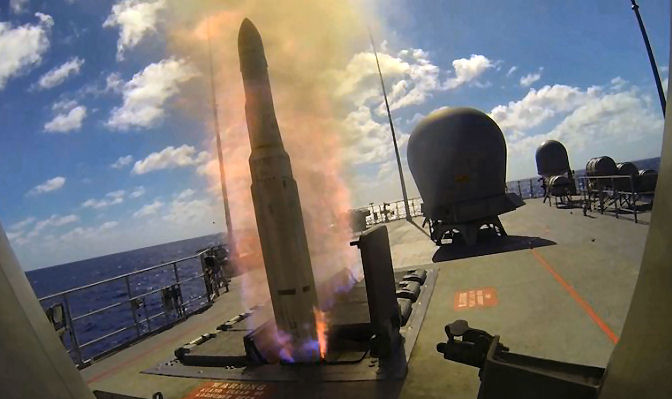 ward off the bad guys. These include an advanced package of air and
surface surveillance radars, omni-directional sonar, a mine
avoidance sonar and electronic support systems which talk with
state-of-the-art black boxes. Knowing who is coming after you is all
well and good, but unless you have the facilities to convince them
to stay away, your future wouldn’t be all that good. Toowoomba,
and the rest of her Class, can counter simultaneous threats from
aircraft, surface vessels and submarines all at the same time. They
are fitted with one 5-inch (127 mm) gun capable of firing 20 rounds
per minute, Harpoon anti-ship missiles, ship launched torpedoes and
a vertical launch system for the Evolved Sea Sparrow anti-air
missile. It also carries the
ward off the bad guys. These include an advanced package of air and
surface surveillance radars, omni-directional sonar, a mine
avoidance sonar and electronic support systems which talk with
state-of-the-art black boxes. Knowing who is coming after you is all
well and good, but unless you have the facilities to convince them
to stay away, your future wouldn’t be all that good. Toowoomba,
and the rest of her Class, can counter simultaneous threats from
aircraft, surface vessels and submarines all at the same time. They
are fitted with one 5-inch (127 mm) gun capable of firing 20 rounds
per minute, Harpoon anti-ship missiles, ship launched torpedoes and
a vertical launch system for the Evolved Sea Sparrow anti-air
missile. It also carries the
.jpg) of which the Navy has 16, is a naval version of the Army’s Blackhawk
and these aircraft have been around since 1988. The Seahawk's main
weapon is the Mk46 anti-submarine torpedo. Navy did plan to replace
them with the Super Seasprite but that plan was ditched in 2008
after huge tech problems and cost over-runs sent it to the “too hard
basket.”
of which the Navy has 16, is a naval version of the Army’s Blackhawk
and these aircraft have been around since 1988. The Seahawk's main
weapon is the Mk46 anti-submarine torpedo. Navy did plan to replace
them with the Super Seasprite but that plan was ditched in 2008
after huge tech problems and cost over-runs sent it to the “too hard
basket.” 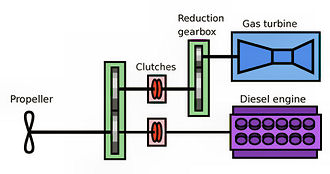 excess of 6,000 nautical miles at 18 knots. The CODOG system works
much like a Toyota Prius in that it consists of two separate and
different engine systems which can be used independently or
together. Toowoomba has two 8,840 hp diesel engines as well as a
30,170 hp gas turbine engine. Normally the ship would run on its
diesels, each one driving a variable pitch propeller, but when extra
speed is needed, the gas turbine is cranked up and through a system
of clutches, can input the extra power needed to propel the ship at
the required increased speed.
excess of 6,000 nautical miles at 18 knots. The CODOG system works
much like a Toyota Prius in that it consists of two separate and
different engine systems which can be used independently or
together. Toowoomba has two 8,840 hp diesel engines as well as a
30,170 hp gas turbine engine. Normally the ship would run on its
diesels, each one driving a variable pitch propeller, but when extra
speed is needed, the gas turbine is cranked up and through a system
of clutches, can input the extra power needed to propel the ship at
the required increased speed. .jpg) September, was assigned to Combined Task Force 151 (CTF-151). She
was the first Australian warship to work with CTF-151, a US-led,
multinational force tasked with protecting merchant vessels from
pirate attacks off the coast of Somalia.
September, was assigned to Combined Task Force 151 (CTF-151). She
was the first Australian warship to work with CTF-151, a US-led,
multinational force tasked with protecting merchant vessels from
pirate attacks off the coast of Somalia.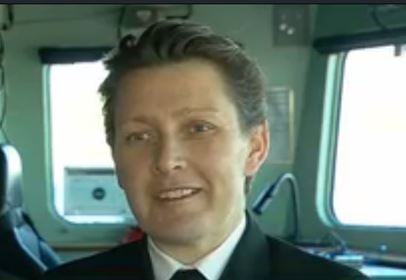 the Middle East. On the 6th June, the ship’s crew travelled to
Toowoomba for a celebration. The event was a Freedom of Entry
ceremony, a custom based in Medieval times bestowing the honour of
welcome to a group of armed troops. Cities in those times had to be
very careful of allowing large bands of armed men within the city
walls after bitter experience showed it was just as likely that the
city would be sacked and plundered as protected. Freedom of Entry to
a city was a huge honour for a group of armed forces which would
otherwise have had to spend the night outside the city walls without
access to food, beds or supplies. HMAS Toowoomba’s Commanding
Officer, Commander Cath Hayes, was issued the “Keys” by Queensland
Police Commissioner Ian Stewart before being welcomed into the city.
the Middle East. On the 6th June, the ship’s crew travelled to
Toowoomba for a celebration. The event was a Freedom of Entry
ceremony, a custom based in Medieval times bestowing the honour of
welcome to a group of armed troops. Cities in those times had to be
very careful of allowing large bands of armed men within the city
walls after bitter experience showed it was just as likely that the
city would be sacked and plundered as protected. Freedom of Entry to
a city was a huge honour for a group of armed forces which would
otherwise have had to spend the night outside the city walls without
access to food, beds or supplies. HMAS Toowoomba’s Commanding
Officer, Commander Cath Hayes, was issued the “Keys” by Queensland
Police Commissioner Ian Stewart before being welcomed into the city.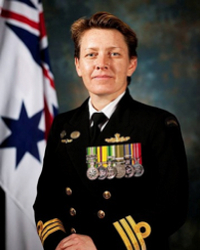 studied
for and was awarded a Bachelor of Science majoring in Oceanography.
On completion of University studies Midshipman Hayes commenced
Seaman Officer training at HMAS Watson, during this time she was
promoted to the rank of Sub-Lieutenant.
studied
for and was awarded a Bachelor of Science majoring in Oceanography.
On completion of University studies Midshipman Hayes commenced
Seaman Officer training at HMAS Watson, during this time she was
promoted to the rank of Sub-Lieutenant.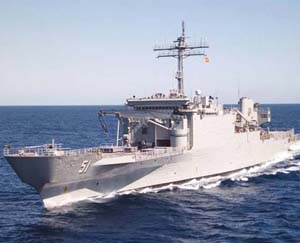 2004 Boxing Day Tsunami she deployed in Kanimbla to Sumatra as part
of Operation SUMATRA ASSIST, to provide humanitarian assistance in
Banda Aceh and later to provide humanitarian assistance to Nias
Island following a subsequent earthquake. Lieutenant Hayes received
a Deputy Commander of Joint Operations Commendation for her work as
the Operations Officer of Kanimbla during Operation SUMATRA ASSIST.
2004 Boxing Day Tsunami she deployed in Kanimbla to Sumatra as part
of Operation SUMATRA ASSIST, to provide humanitarian assistance in
Banda Aceh and later to provide humanitarian assistance to Nias
Island following a subsequent earthquake. Lieutenant Hayes received
a Deputy Commander of Joint Operations Commendation for her work as
the Operations Officer of Kanimbla during Operation SUMATRA ASSIST.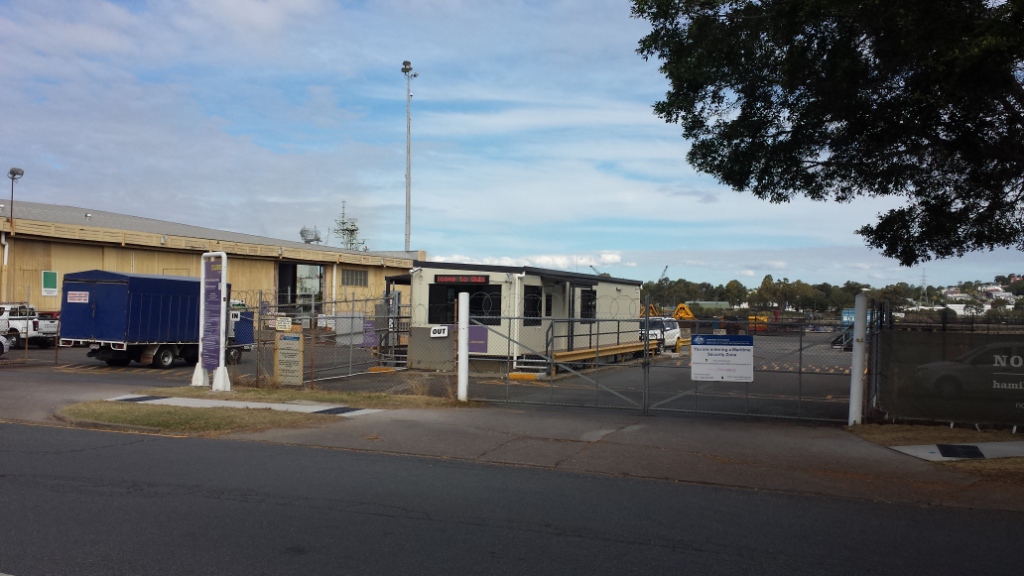 “back
end” and surrendered our licences in return for a visitor’s pass. We
were then shown below decks, via some pretty steep stairs, to the
Seaman’s Mess, which they call the Galley where a very generous
breakfast was being served and to which we were invited to partake.
“back
end” and surrendered our licences in return for a visitor’s pass. We
were then shown below decks, via some pretty steep stairs, to the
Seaman’s Mess, which they call the Galley where a very generous
breakfast was being served and to which we were invited to partake.
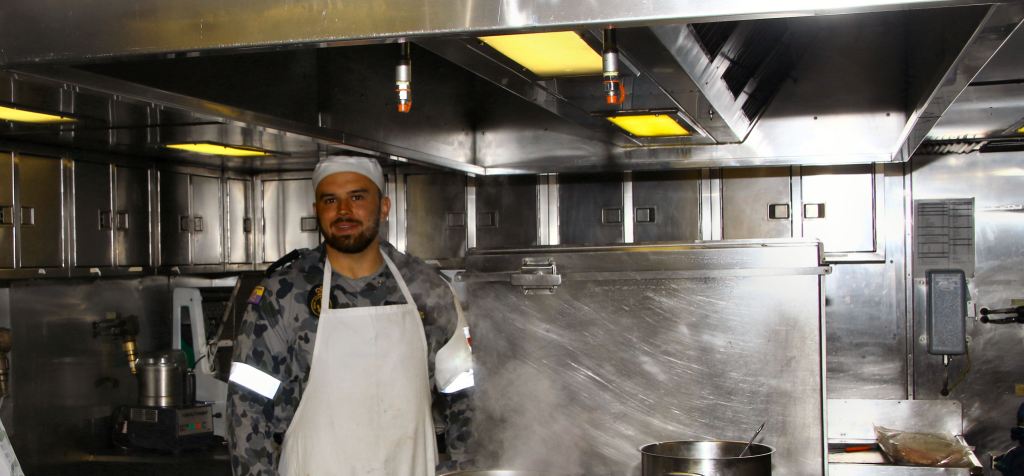
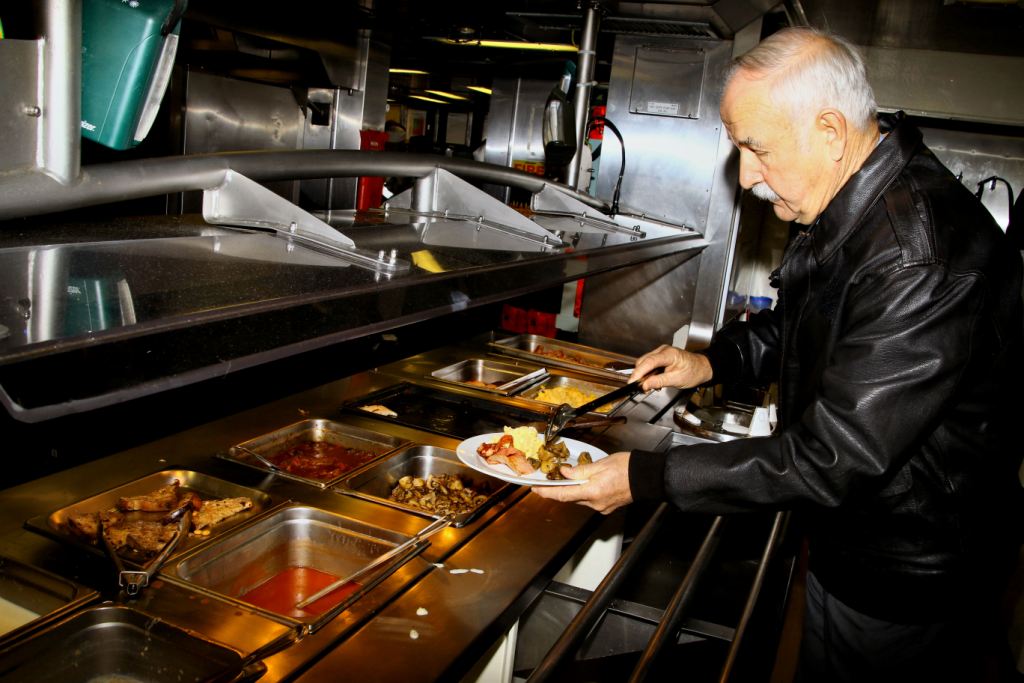
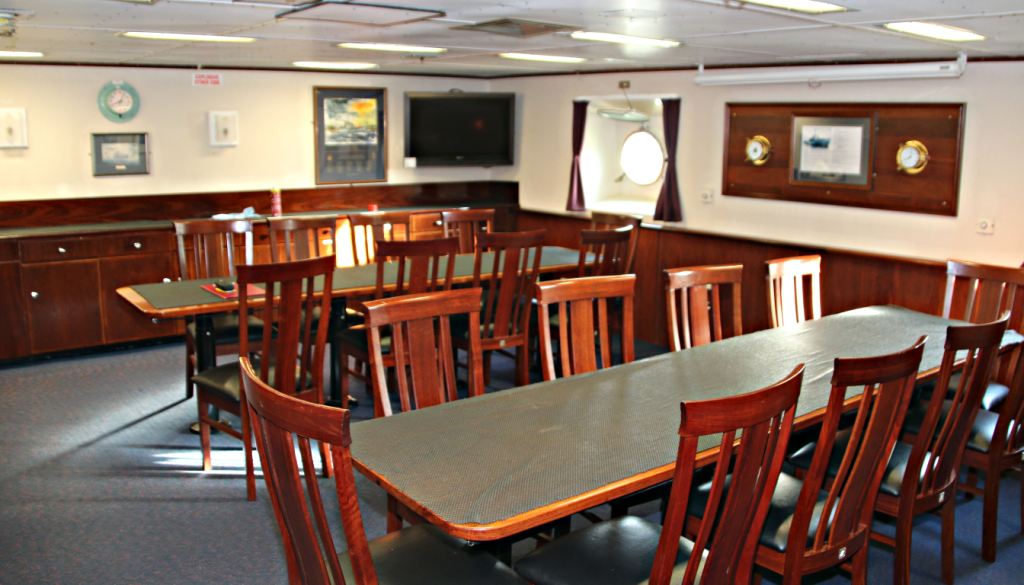
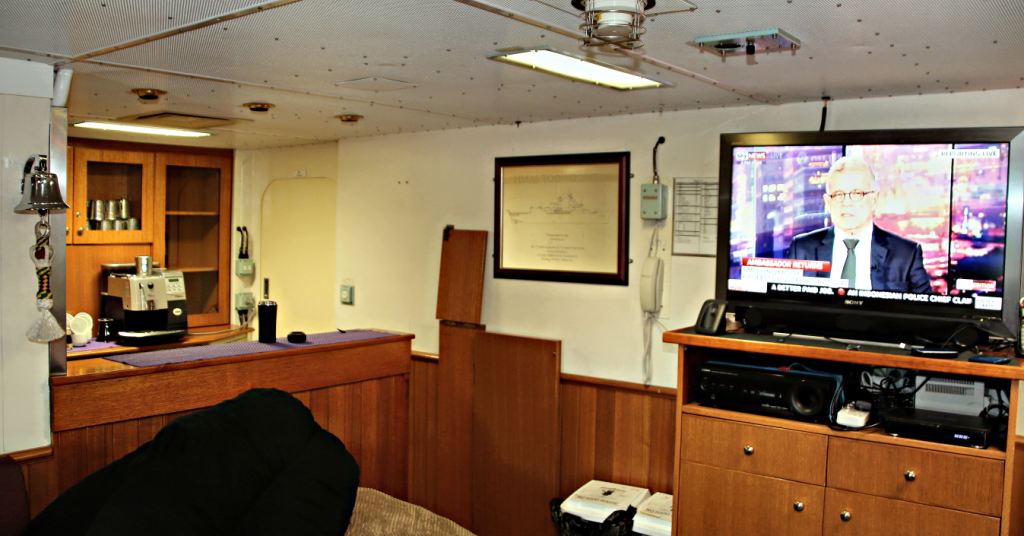
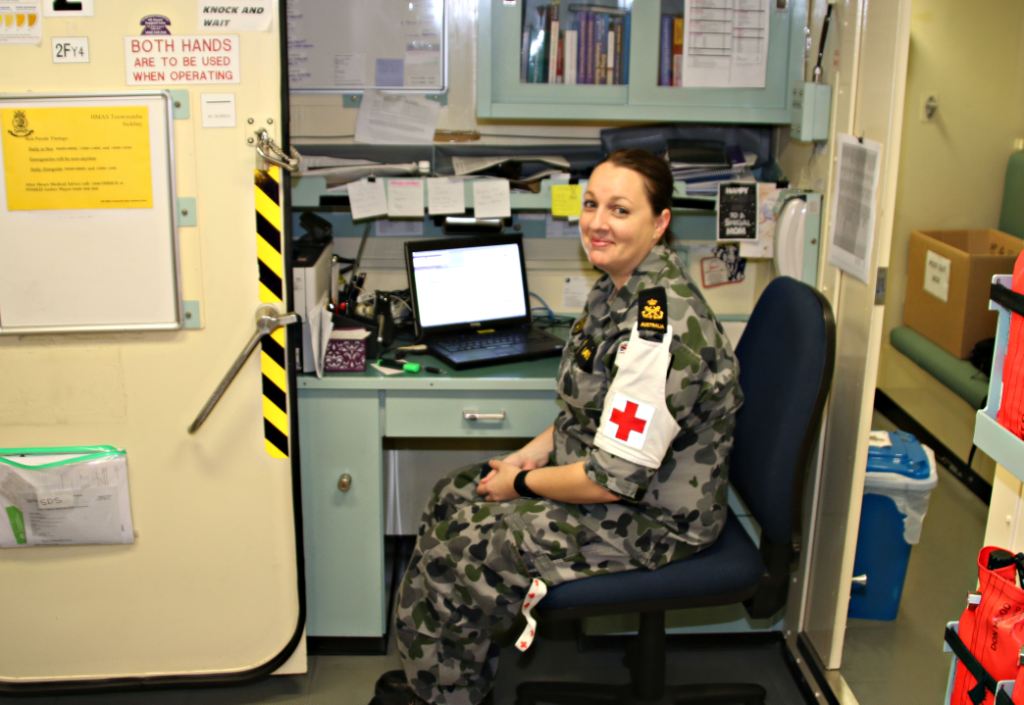
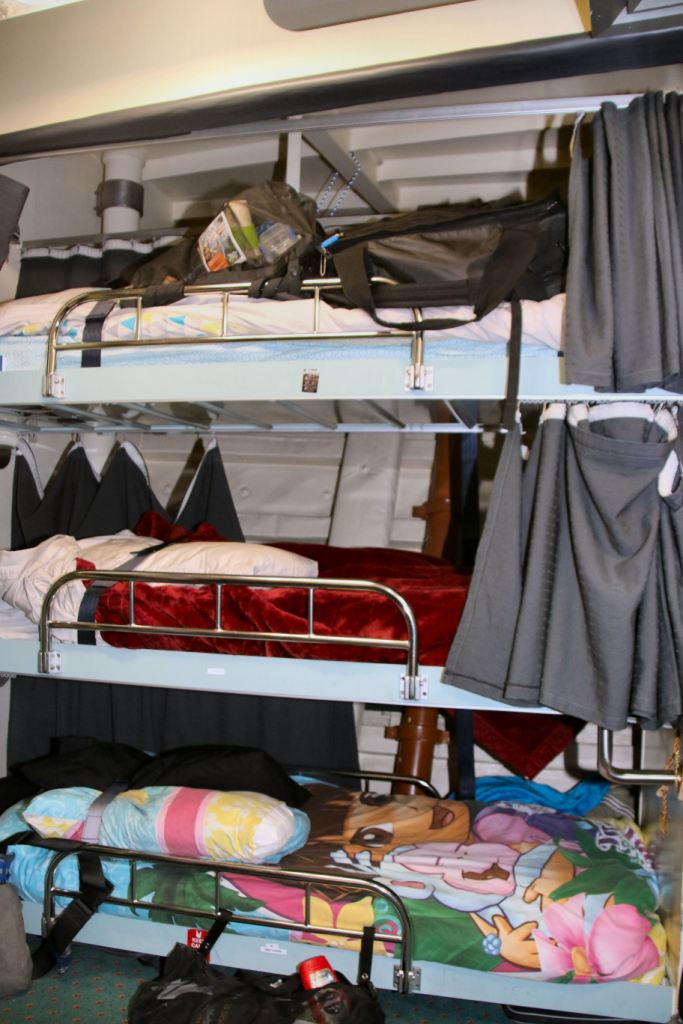
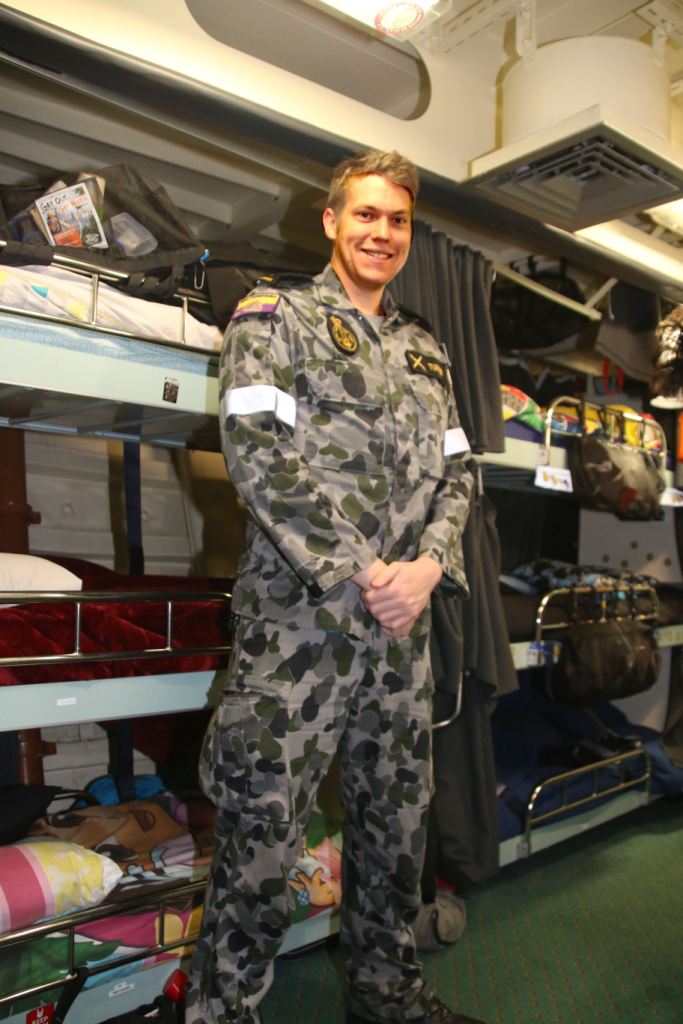
.jpg)
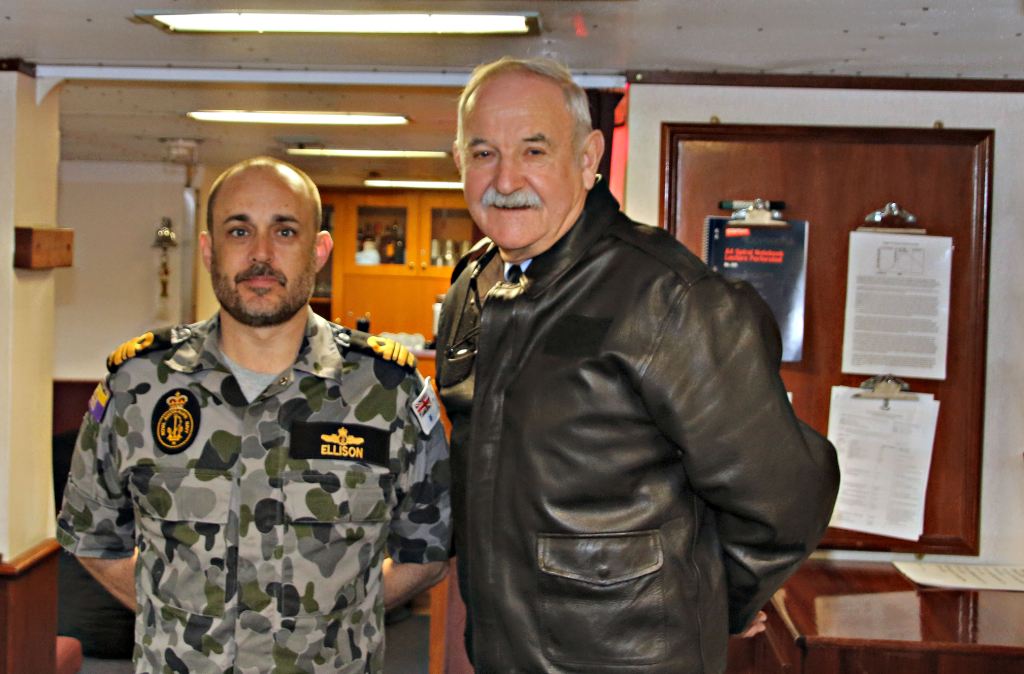
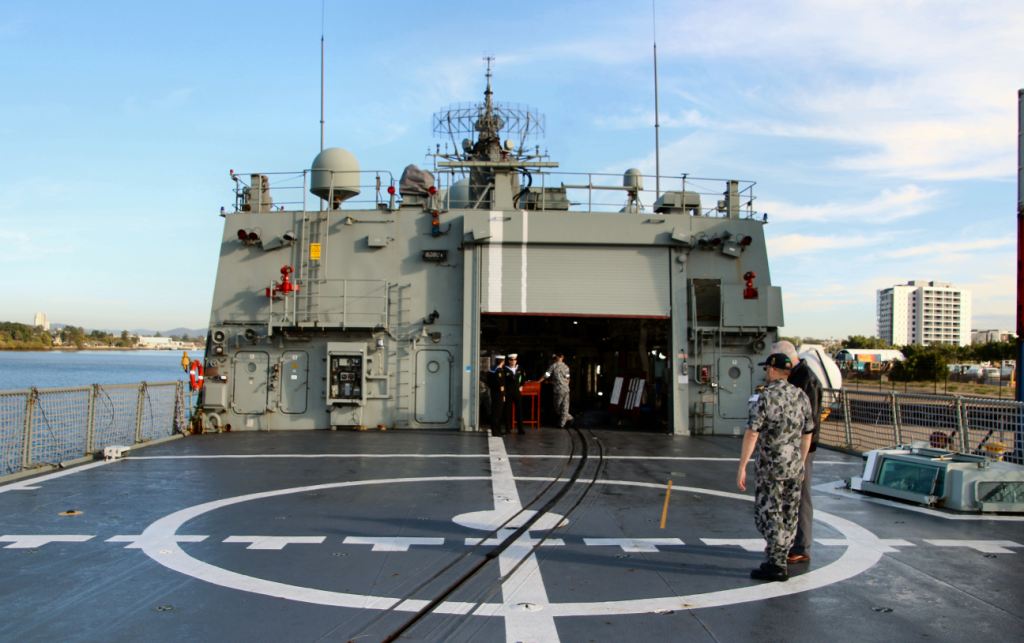
.jpg)
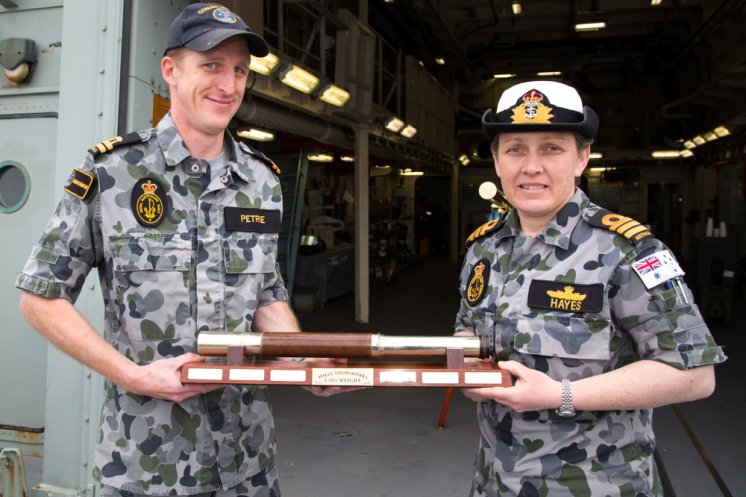
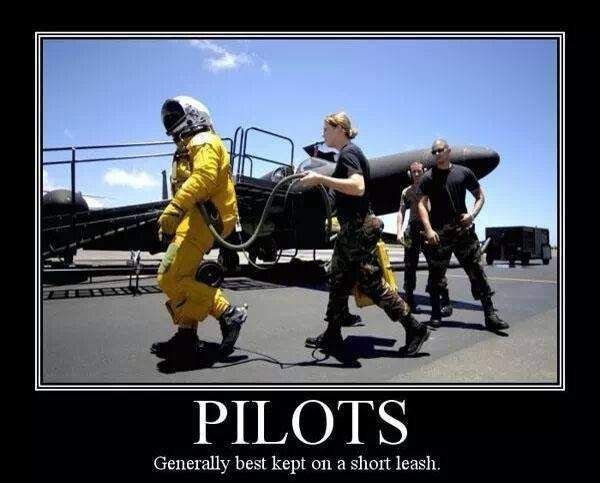
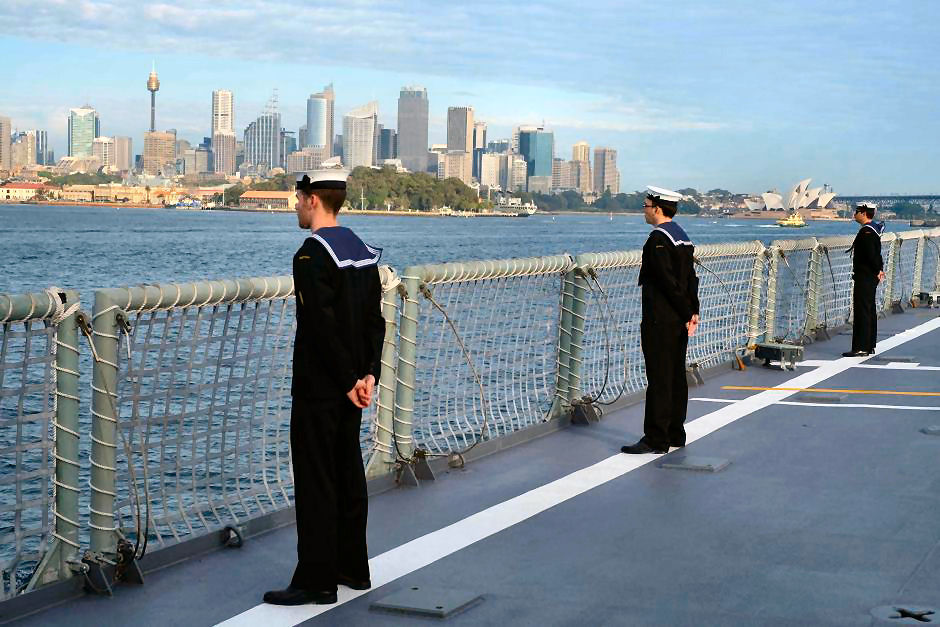
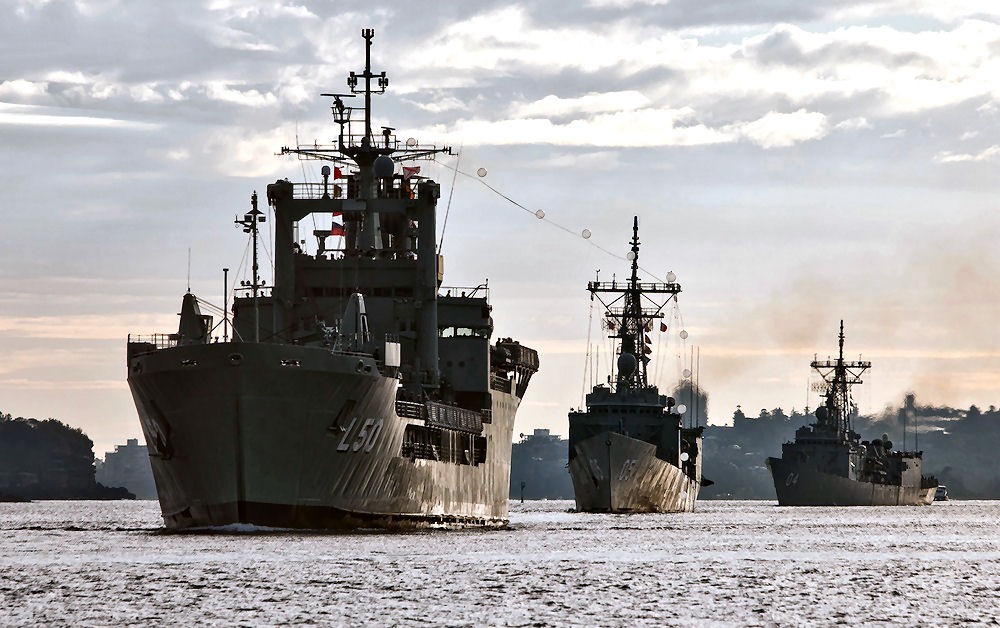
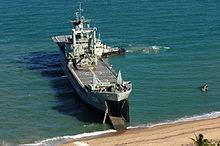 sealift capability, preferably through the acquisition of a
dedicated cargo ship. The chartering of civilian ships to provide
this capability when required, as had been done with the merchant
vessels Jeparit and Boonaroo during the Vietnam War, was considered
and rejected because Australian National Line was unable to provide
the necessary level of support. It was decided that a purpose-built
ship would be constructed for the role and would be operated by the
RAN. While the Army did not require that the ship be capable of
beaching, the RAN set this as a requirement, to maximise the ship's
flexibility. In 1975, the Navy successfully convinced Australian
Military's Force Structure Committee to endorse this requirement
over the Army's opposition and the committee authorised the purchase
of a Landing Ship Heavy (LSH) on 19 March 1975.
sealift capability, preferably through the acquisition of a
dedicated cargo ship. The chartering of civilian ships to provide
this capability when required, as had been done with the merchant
vessels Jeparit and Boonaroo during the Vietnam War, was considered
and rejected because Australian National Line was unable to provide
the necessary level of support. It was decided that a purpose-built
ship would be constructed for the role and would be operated by the
RAN. While the Army did not require that the ship be capable of
beaching, the RAN set this as a requirement, to maximise the ship's
flexibility. In 1975, the Navy successfully convinced Australian
Military's Force Structure Committee to endorse this requirement
over the Army's opposition and the committee authorised the purchase
of a Landing Ship Heavy (LSH) on 19 March 1975. 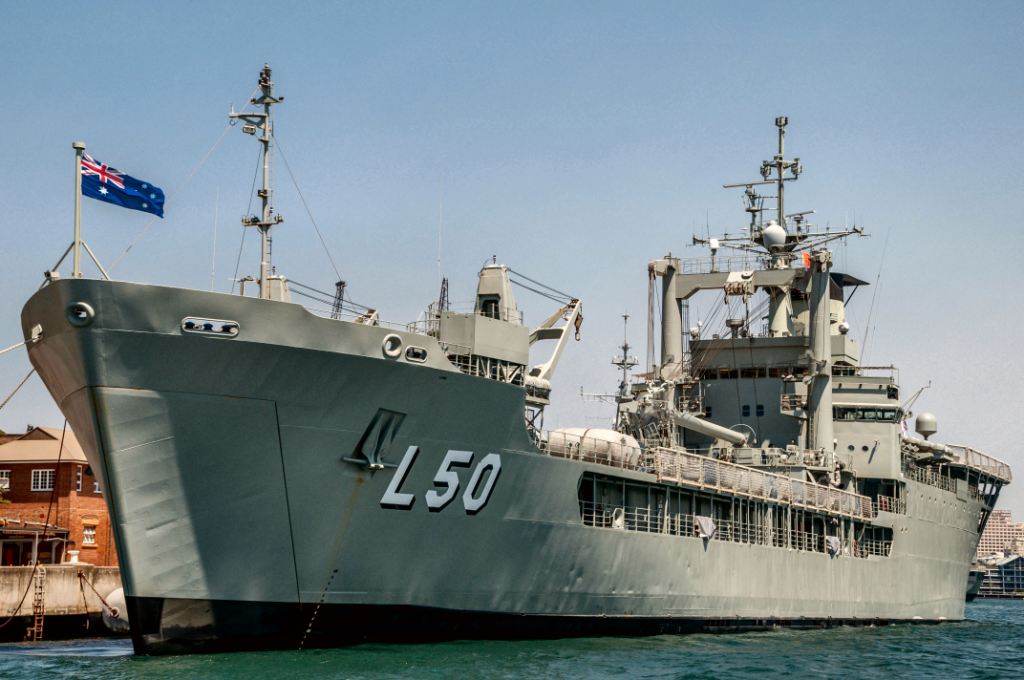 class, which had been modified following the RFA”s experience
with operating the class' lead ship, RFA Sir Lancelot. The ship was
designed as a multi-purpose, roll-on/roll-off heavy lift and
transport vessel. The Australian modifications to the design were
kept to a minimum to simplify construction, the most significant
changes were to improve the ship's ability to operate both large and
multiple helicopters, fitting an operations room and adding a
derrick with a lift of 70 tonnes. Most of the other changes related
to bringing accommodation conditions into line with Australian
requirements. Like the other ships of the Round Table class, Tobruk
was built to commercial rather than military standards, and is
unable to sustain as much damage as warships.
class, which had been modified following the RFA”s experience
with operating the class' lead ship, RFA Sir Lancelot. The ship was
designed as a multi-purpose, roll-on/roll-off heavy lift and
transport vessel. The Australian modifications to the design were
kept to a minimum to simplify construction, the most significant
changes were to improve the ship's ability to operate both large and
multiple helicopters, fitting an operations room and adding a
derrick with a lift of 70 tonnes. Most of the other changes related
to bringing accommodation conditions into line with Australian
requirements. Like the other ships of the Round Table class, Tobruk
was built to commercial rather than military standards, and is
unable to sustain as much damage as warships.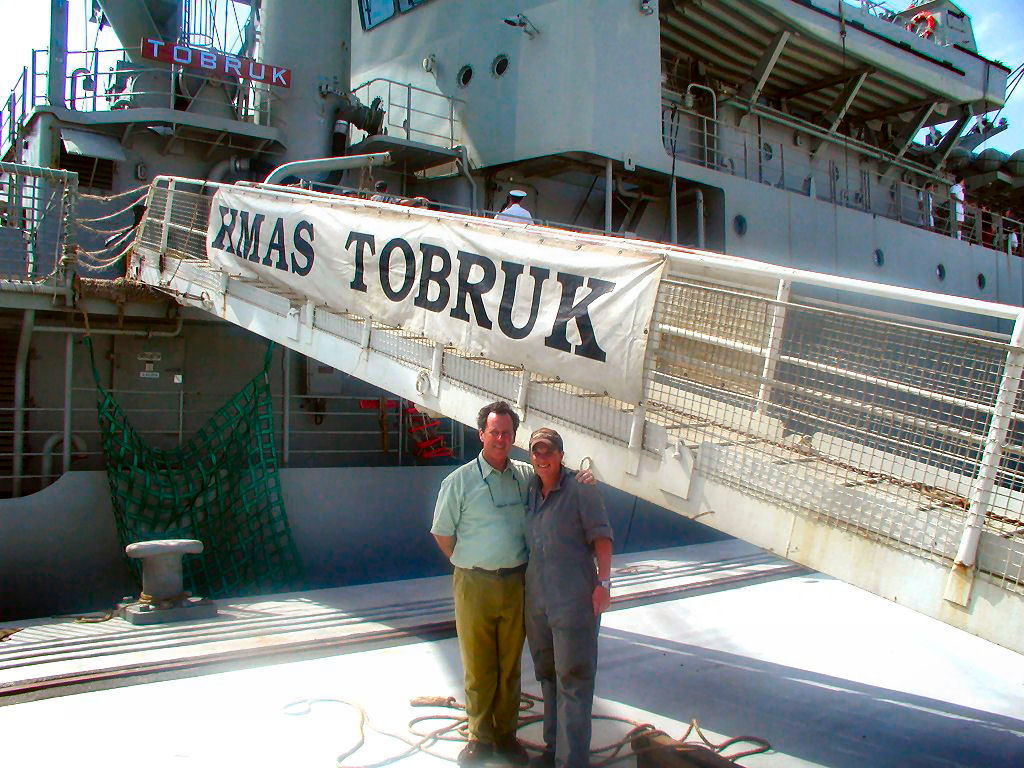 completed a Navy cadet was fatally gassed when the
ship's sewerage system malfunctioned during trials.
completed a Navy cadet was fatally gassed when the
ship's sewerage system malfunctioned during trials.